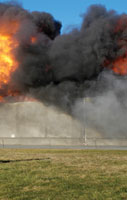
While it might seem that OSHA has lagged in coming up with dust explosion standards for industries other than grain (see Food Engineering June 2008), the National Fire Protection Association (NFPA) has declared that its NFPA 68 Standard on Explosion Protection by Deflagration Venting is now a “standard” rather than a “guideline.” According to Lee Morgan, president of Farr Air Pollution Control (Farr APC), the NFPA standard provides mandatory requirements for dust collection applications involving explosive dusts, and the standard incorporates much more stringent requirements than past editions. Several food plants have received unannounced visits from OSHA as it has stepped up its inspections. But adherence to NFPA standards will be more immediate.
“Most insurance agencies and local fire codes state that NFPA standards shall be followed as code,” says Morgan, “so in nearly every town and county in the US, NFPA 68 is to be treated as legal code.” To ensure compliance, many food plants will now have to install updated dust collection/explosion venting equipment. Plants are also now required to test their dusts to determine explosivity, commission risk evaluations, maintain extensive documentation and schedule annual inspections. All of these requirements are spelled out in the new standard.
OSHA has identified and contacted 30,000 companies that deal with combustible dusts, warning them of the explosion hazards that exist. “But at the present time, when it comes to enforcement, OSHA is lagging behind the current available information from NFPA,” says Morgan. “Our experience in the field is that the fire marshals and other local authorities are the ones who are stepping up to make factories comply.”
Morgan cites an example: The state of Georgia now has a very proactive safety program. It recently staged an intensive training seminar led by NFPA experts on the topic of combustible dusts. Although it was aimed at fire marshals and other officials, the seminar was open to plant managers, safety engineers and anyone else who wanted to attend.
Unfortunately, progress is slow-not only with OSHA but with acceptance at the individual plant level. “Many people don’t fully understand the risk,” says Morgan, “or they don’t realize that it applies to their situation. I believe we will start to see more training programs at state and local levels, perhaps following the Georgia model.”

